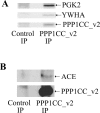Proteomic analysis of bovine sperm YWHA binding partners identify proteins involved in signaling and metabolism
- PMID: 18753613
- PMCID: PMC2780472
- DOI: 10.1095/biolreprod.108.068734
Proteomic analysis of bovine sperm YWHA binding partners identify proteins involved in signaling and metabolism
Abstract
Posttranslational modification of proteins by phosphorylation is involved in regulation of sperm function. Protein phosphatase 1 gamma isoform 2 (PPP1CC_v2) and protein YWHA (also known as 14-3-3) are likely to be key molecules in pathways involving sperm protein phosphorylation. We have shown that phosphorylated PPP1CC_v2 is bound to protein YWHAZ in spermatozoa. In somatic cells, protein YWHA is known to bind a number of phosphoproteins involved in signaling and energy metabolism. Thus, in addition to PPP1CC_v2, it is likely that sperm contain other YWHA-binding proteins. A goal of the present study was to identify these sperm YWHA-binding proteins. The binding proteins were isolated by affinity chromatography with GST-YWHAZ followed by elution with a peptide, R-11, which is known to disrupt YWHA complexes. The YWHA-binding proteins in sperm can be classified as those involved in fertilization, acrosome reaction, energy metabolism, protein folding, and ubiquitin-mediated proteolysis. A subset of these putative YWHA-binding proteins contain known amino acid consensus motifs, not only for YWHA binding but also for PPP1C binding. Identification of sperm PPP1CC_v2-binding proteins by microcystin-agarose chromatography confirmed that PPP1CC_v2 and YWHA interactomes contain several common proteins. These are metabolic enzymes phosphoglycerate kinase 2, hexokinase 1, and glucose phosphate isomerase; proteins involved in sperm-egg fusion; angiotensin-converting enzyme, sperm adhesion molecule, and chaperones; heat shock 70-kDa protein 5 (glucose-regulated protein 78 kDa; and heat shock 70-kDa protein 1-like. These proteins are likely to be phosphoproteins and potential PPP1CC_v2 substrates. Our data suggest that in addition to potential regulation of a number of important sperm functions, YWHA may act as an adaptor molecule for a subset of PPP1CC_v2 substrates.
Figures






Similar articles
-
Phosphorylation-dependent interaction of tyrosine 3-monooxygenase/tryptophan 5-monooxygenase activation protein (YWHA) with PADI6 following oocyte maturation in mice.Biol Reprod. 2008 Aug;79(2):337-47. doi: 10.1095/biolreprod.108.069328. Epub 2008 May 7. Biol Reprod. 2008. PMID: 18463355 Free PMC article.
-
Protein 14-3-3zeta binds to protein phosphatase PP1gamma2 in bovine epididymal spermatozoa.Biol Reprod. 2004 Jul;71(1):177-84. doi: 10.1095/biolreprod.104.027284. Epub 2004 Mar 17. Biol Reprod. 2004. PMID: 15028637
-
Identification of bovine sperm acrosomal proteins that interact with a 32-kDa acrosomal matrix protein.Mol Cell Biochem. 2016 Mar;414(1-2):153-69. doi: 10.1007/s11010-016-2668-3. Epub 2016 Feb 20. Mol Cell Biochem. 2016. PMID: 26897631 Free PMC article.
-
Protein phosphorylation in mammalian spermatozoa.Reproduction. 2003 Jan;125(1):17-26. doi: 10.1530/rep.0.1250017. Reproduction. 2003. PMID: 12622692 Review.
-
Phosphoprotein phosphatase 1 complexes in spermatogenesis.Curr Mol Pharmacol. 2014;7(2):136-46. doi: 10.2174/1874467208666150126154222. Curr Mol Pharmacol. 2014. PMID: 25620225 Review.
Cited by
-
YWHA (14-3-3) protein isoforms and their interactions with CDC25B phosphatase in mouse oogenesis and oocyte maturation.BMC Dev Biol. 2019 Oct 22;19(1):20. doi: 10.1186/s12861-019-0200-1. BMC Dev Biol. 2019. PMID: 31640562 Free PMC article.
-
Identification of testis 14-3-3 binding proteins by tandem affinity purification.Spermatogenesis. 2011 Oct;1(4):354-365. doi: 10.4161/spmg.1.4.18902. Epub 2011 Oct 1. Spermatogenesis. 2011. PMID: 22332119 Free PMC article.
-
Two distinct Ca(2+) signaling pathways modulate sperm flagellar beating patterns in mice.Biol Reprod. 2011 Aug;85(2):296-305. doi: 10.1095/biolreprod.110.089789. Epub 2011 Mar 9. Biol Reprod. 2011. PMID: 21389347 Free PMC article.
-
Selective ablation of Ppp1cc gene in testicular germ cells causes oligo-teratozoospermia and infertility in mice.Biol Reprod. 2013 Nov 27;89(5):128. doi: 10.1095/biolreprod.113.110239. Print 2013 Nov. Biol Reprod. 2013. PMID: 24089200 Free PMC article.
-
Occurrence and functional significance of the transcriptome in bovine (Bos taurus) spermatozoa.Sci Rep. 2017 Mar 9;7:42392. doi: 10.1038/srep42392. Sci Rep. 2017. PMID: 28276431 Free PMC article.
References
-
- Urner F, Sakkas D.Protein phosphorylation in mammalian spermatozoa. Reproduction 2003; 125: 17–26.. - PubMed
-
- Vijayaraghavan S, Goueli SA, Davey MP, Carr DW.Protein kinase A-anchoring inhibitor peptides arrest mammalian sperm motility. J Biol Chem 1997; 272: 4747–4752.. - PubMed
-
- Burton KA, Treash-Osio B, Muller CH, Dunphy EL, McKnight GS.Deletion of type IIalpha regulatory subunit delocalizes protein kinase A in mouse sperm without affecting motility or fertilization. J Biol Chem 1999; 274: 24131–24136.. - PubMed
-
- Vijayaraghavan S, Mohan J, Gray H, Khatra B, Carr DW.A role for phosphorylation of glycogen synthase kinase-3alpha in bovine sperm motility regulation. Biol Reprod 2000; 62: 1647–1654.. - PubMed
Publication types
MeSH terms
Substances
Grants and funding
LinkOut - more resources
Full Text Sources
Research Materials

